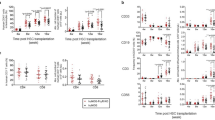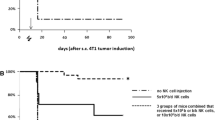Abstract
The antitumor effects of three biological response modifiers (BRMs; PSK, IFNα A/D and OK432) and two chemotherapeutics (Mitomycin C and Neocarzinostatin) in a new experimental mouse model, the “double grafted tumor system,” were evaluated. BALB/c mice received simultaneous inoculations of Meth A fibrosarcoma cells on right flank (1 × 106 cells) and left flank (2 × 105 cells) on day 0, and drugs were given intratumorally into the right-flank tumor on day 3. The growth of the left-flank tumor was the real target for the evaluation of a given drug after 21 days. All tested five agents successfully cured the drug-injected right tumor with a pre-determined optimum dose. In addition, PSK, OK432, IFNα A/D and MMC among the five, inhibited the left-flank tumor, whereas no inhibition was observed when treated with NCS. To understand the mechanism by which the antitumor effect of the above four agents is able to influence the growth of tumor on the other side, tumor cells (2 × 105 cells) inoculated only into the left flank were treated with drugs given subcutaneously to the right flank (single tumor system). Among the four, MMC exhibited an effect similar to that obtained in the double tumor system, and IFNα A/D showed a less pronounced but still definite antitumor effect. However, PSK and OK432 failed to express anti-tumor effect in the single tumor system. These results obtained with PSK, OK432 and IFNαA/D suggest that the effect of the drug on the left-tumor may be mediated by certain effector cells, which are specifically induced by injection of the drug, in the right-tumor tissues. When effector cell analysis was conducted with spleen cells obtained after PSK treatment by means of intratumoral adoptive transfer into 3-day Meth A bearing recipients, these cells were shown to be Lyt-1+2−-T and L3T4+-T cell.
Similar content being viewed by others
References
Hanna MG, Zbar B, Rapp HJ. Histopathology of tumor regression after intralesional injection of Mycobacterium bovis. I. Tumor growth and metastasis. J Natl Cancer Inst 1972; 48: 1441–55.
Bartlett GL, Zbar B, Rapp HJ. Suppression of murine tumor growth by immune reaction to the Bacillus Calmette-Guerin strain of Mycobacterium bovis. J Natl Cancer Inst 1972; 48: 245–57.
Salomon JC, Lynch NR, Gheorghiu M, Galinha A, Lascaux V, Prin J. Resistance factors to intralesional immunotherapy with BCG or Corynebacterium parvum in rat tumors. Cancer Immunol Immunother 1981; 10: 87–97.
Sakita M, Kasuga M, Yamane T, Torii T, Imai H, Kageyama N, Fujita Y, Majima S. Intratumor immunochemotherapy with 5-fluorouracil emulsion and BCG in C3H/He mice transplanted with MH 134. Gann 1982; 73: 931–7.
Ribi E, Amano K, Cantrell J, Schwartzman S, Parker R, Takayama K. Preparation and antitumor activity of non toxic lipid A. Cancer Immunol Immunother 1982; 12: 91–96.
Ohanian SH, Schlager SI, Goodman D. Analysis of the intralesional Adriamycin-induced regression of primary and metastatic growth of line-10 guinea pig hepatoma. Cancer Immunol Immunother 1980; 8: 179–87.
Kohya H, Ishii F, Takano S, Katori T, Ebina T, Ishida N. Antitumor effect of a synthetic cord factor, 6,6′-di-o-decanoyl-α,α-trehalose (SS554), in mice. Jpn J Cancer Res (Gann) 1986; 77: 602–9.
Yarkoni E, Lederer E, Rapp HJ. Immunotherapy of experimental cancer and trehalose dimycolate. Infect Immunity 1981; 32: 273–6.
Fisher B, Gunduz N, Saffer EA. Influence of the interval between primary tumor removal and chemotherapy of kinetics and growth of metastases. Cancer Res 1983; 43: 1488–92.
Bier J, Rapp GJ, Borsos T, Zbar B. Randomized clinical study on intratumoral BCG-cell wall preparation (CWP) therapy in patients with squamous cell carcinoma in the head and neck region. Cancer Immunol Immunother 1981; 12: 71–9.
Hersh EM, Quesada J, Murphy SG, Gutterman JU, Hutchins RD. Evaluation of therapy with methanol extraction residue of BCG (MER). Cancer Immunol Immunother 1982; 14: 4–9.
Ebina T, Kohya H, Yamaguchi T, and Ishida N. Antimetastatic effect of biological response modifiers in the “double grafted tumor system”. Jpn J Cancer Res (Gann) 1986; 77: 1034–42.
Ebina T, Kohya H, Inoue H, Aso H. Antitumor effect of PSK (1): Interferon-inducing activity and intratumoral administration. Jpn J Cancer Chemother 1987; 14: 1841–6.
Ebina T, Kohya H. Antitumor effect of PSK (2): Effector mechanism of antimetastatic effect in the “double grafted tumor system”. Jpn J Cancer Chemother 1987; 14: 1847–53.
Ebina T, Kohya H. Antitumor effector mechanism at a distant site in the double grafted tumor system of PSK, a protein-bound polysaccharide preparation. Jpn J Cancer Res (Gann) 1988; 79: 957–64.
16. Lichtenstein A. Antitumor effect of the streptococcal preparation OK-432 in a murine model of ovarian cancer. Cancer Immunol Immunother 1987; 24: 172–7.
Peppoloni S, Mathieson BJ, Gerberman RB, Oveton RW, Gorelik E. In vivo resistance of secondary antitumor immune response to cyclophosphamide: effects on T cell subsets. Cancer Immunol Immunother 1987; 24: 49–56.
North RJ. Cyclophosphamide-facilitated adoptive immunotherapy of an established tumor depends on elimination of tumor-induced suppressor T cells. J Exp Med 1982; 55: 1063–74.
Dialynas DP, Quan ZS, Wall KA, Pierres A, Quintance J, Loken MR, Pierres M, Fitch FW. Characterization of the murine T cell surface molecule, designated L3T4, identified by monoclonal antibody GK1.5: similarity of L3T4 to the human Leu-3/T4 molecule. J Immunol 1983; 131: 2445–51.
Wilde DB, Marrack P, Kappler J, Dialynas DP, Fitch FW. Evidence implicating L3T4 in class II MHC antigen reactivity; monoclonal antibody GK1.5 (anti-L3T4a) blocks class II MHC antigen-specific proliferation, release of lymphokines, and binding by cloned murine helper T lymphocyte fines. J Immunol 1983; 131: 2178–83.
Gutstein NL, Seaman WE, Scott JH, Wofsy D. Induction of immune tolerance by administration of monoclonal antibody to L3T4. J Immunol 1986; 137: 1127–32.
Cheever MA, Greenberg PD, Fefer A. Chemoimmunotherapy of a Friend leukemia with cells secondarily sensitized in vitro: effect of culture duration on therapeutic efficacy. J Natl Cancer Inst 1981; 67: 169–73.
Greenberg PD, Cheever MA, Fefer A. Eradication of disseminated murine leukemia by chemoimmunotherapy with cyclophosphamide and adoptive transferred immune syngeneic Lyt-1+2− lymphocytes. J Exp Med 1981; 154: 952–63.
Johnson CS, Thurlow SM, Furmanski P. Induction of leukemia regression in mice by immunotherapeutic transfer of T-lymphocytes. Cancer Res 1986; 46: 183–9.
De Weger RA, Wilbrink B, Moberts RM, Mans D, Oskam R, Otter WD. Immune reactivity in SL2 lymphoma bearing mice compared with SL2-immunized mice. Cancer Immunol Immunother 1987; 24: 25–36.
North RJ, Kirstein DP. T-cell-mediated concomitant immunity to syngeneic tumors 1. Activated macrophages as the expressor of nonspecific immunity to unrelated tumors and bacterial parasites. J Exp Med 1977; 145: 275–92.
Dullens HFJ, Vuist W, Maas MV, Otter WD. The role of host lymphocytes and host macrophages in antitumor reactions after injection of sensitized lymphocytes and tumor target cells into naive mice. Cancer Immunol Immunother 1986; 23: 113–8.
Yoshioka T, Fujiwara H, Takai Y, Ogata M, Shimizu J, Hamaoka T. The role of tumor-specific Lyt-1+2− T cells in eradicating tumor cells in vivo II. Lyt-1+2− T cells have potential to reject antigenically irrelevant (bystander) tumor cells on activation with the specific target tumor cells. Cancer Immunol Immunother 1987; 24: 8–12.
Ogura T, Hara H, Yokota S, Hosoe S, Kawase I, Kishimoto S, Yamamura Y. Effector mechanism in concomitant immunity potentiated by intratumoral injection of Nocardia rubra cell wall skeleton. Cancer Res 1985; 45: 6371–5.
Saito M, Ichimura O, Kataoka M, Moriya Y, Ueno K, Sugawara Y, Nanjo M, Ishida N. Pronounced antitumor effect of LAK-like cells induced in the peritoneal cavity of mice after intraperitoneal injection of OK-432, a killed Streptococcal preparation. Cancer Immunol Immunother 1986; 22: 161–8.
Grimm EA, Ramsey KM, Mazumder A, Wilson DJ, Djeu JY, Rosenberg SA. Lymphokine-activated killer cell phenomenon II. Precursor phenotype is serologically distinct from peripheral T lymphocytes, memory cytotoxic thymus-derived lymphocytes, and natural killer cells. J Exp Med 1983; 157: 884–97.
Evans R, Duffy T. The immunological basis of tumor rejection: The absolute dependence of the effector arm on sensitized T cells after chemoimmunotherapy of a murine sarcoma. J Immunol 1985; 134: 4255–60.
Chen YH, Anderson AB, Williams KG. Splenic immune effector and suppressor cells in mice bearing a growing plasmacytoma. Cancer Res 1985; 45: 5473–9.
Fisher B, Fisher ER. Studies concerning the regional lymph node in cancer II. Maintenance of immunity. Cancer 1972; 29: 1496–1501.
Fisher B, Fisher ER. Studies concerning the regional lymph node in cancer I. Initiation of immunity. Cancer 1971; 27: 1001–4.
Fisher B, Fisher ER. The interrelationship of hematogenous and lymphatic tumor cell dissemination. Surg Gynecol Obst 1966; April: 791–8.
Author information
Authors and Affiliations
Rights and permissions
About this article
Cite this article
Kohya, H., Ebina, T., Yamaguchi, T. et al. The “double grafted tumor system”, proposed to find effector cells in the analyses of antitumor effect of BRMs. Biotherapy 1, 139–151 (1989). https://doi.org/10.1007/BF02170883
Received:
Accepted:
Issue Date:
DOI: https://doi.org/10.1007/BF02170883




